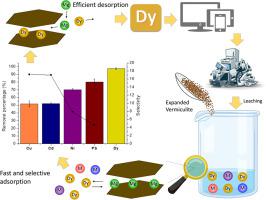Colloids and Surfaces A: Physicochemical and Engineering Aspects ( IF 4.9 ) Pub Date : 2021-09-22 , DOI: 10.1016/j.colsurfa.2021.127616 Giani Vargas Brião 1 , Meuris Gurgel Carlos da Silva 1 , Melissa Gurgel Adeodato Vieira 1

|
Dysprosium obtainment from secondary sources is a current theme in the scientific scenario due to the high demand and environmental issues related to primary production. Hydrometallurgy applied to urban mines can be a potential alternative to separate and recover critical metals as dysprosium. Thus, the present work evaluates the dysprosium adsorption, a secondary separation process in the hydrometallurgical routes, onto expanded vermiculite through kinetic, selectivity, and desorption aspects. The adsorption process had a kinetic governed by the external mass transfer model, in which the primary mechanism of adsorption is the ion exchange. The adsorption efficiency of vermiculite towards dysprosium from a multicomponent solution indicated that the vermiculite adsorbed preferably Dy (97.6%) followed by Pb (80.1%) > Ni (70.1%) > Cd (52.0%) > Cu (51.7%). A desorption efficiency of 89% was reached using magnesium nitrate hexahydrate as eluent (0.2 mol/L), contact time (3 h), and solid/liquid ratio (14 g/L) determined by surface response methodology from a rotational central composite design of experiments. The characterization of the loaded adsorbent indicated that vermiculite, after the adsorption of dysprosium, lost expansion, enlarged the interlayer space due to the exchange of magnesium, and maintained its alumino-phyllosilicate characteristic composition. Therefore, the adsorption of dysprosium is efficient, fast, selective, and did not promote relevant structural changes in the adsorbent structure. Moreover, the very successful dysprosium desorption favors expanding vermiculite as adsorbent in further applications.
中文翻译:

膨胀蛭石上的镝吸附:动力学、选择性和解吸
由于与初级生产相关的高需求和环境问题,从二级来源获取镝是科学情景中的当前主题。应用于城市矿山的湿法冶金可以成为分离和回收镝等关键金属的潜在替代方法。因此,目前的工作通过动力学、选择性和解吸方面评估了湿法冶金路线中的二次分离过程镝吸附到膨胀蛭石上。吸附过程具有由外部传质模型控制的动力学,其中吸附的主要机制是离子交换。蛭石对多组分溶液中镝的吸附效率表明,蛭石优选吸附 Dy (97.6%),其次是 Pb (80.1%) > Ni (70.1%) > Cd (52. 0%) > 铜 (51.7%)。使用六水合硝酸镁作为洗脱液 (0.2 mol/L)、接触时间 (3 h) 和固液比 (14 g/L) 的解吸效率达到 89%,通过旋转中心复合设计的表面响应方法确定的实验。负载吸附剂的表征表明,蛭石在吸附镝后失去膨胀,由于镁的交换而扩大了层间空间,并保持了其铝-页硅酸盐的特征成分。因此,镝的吸附是高效、快速、选择性的,并且不会促进吸附剂结构的相关结构变化。此外,非常成功的镝解吸有利于扩大蛭石作为进一步应用中的吸附剂。使用六水合硝酸镁作为洗脱液 (0.2 mol/L)、接触时间 (3 h) 和固液比 (14 g/L) 的解吸效率达到 89%,通过旋转中心复合设计的表面响应方法确定的实验。负载吸附剂的表征表明,蛭石在吸附镝后失去膨胀,由于镁的交换而扩大了层间空间,并保持了其铝-页硅酸盐的特征成分。因此,镝的吸附是高效、快速、选择性的,并且不会促进吸附剂结构的相关结构变化。此外,非常成功的镝解吸有利于扩大蛭石作为进一步应用中的吸附剂。使用六水合硝酸镁作为洗脱液 (0.2 mol/L)、接触时间 (3 h) 和固液比 (14 g/L) 的解吸效率达到 89%,通过旋转中心复合设计的表面响应方法确定的实验。负载吸附剂的表征表明,蛭石在吸附镝后失去膨胀,由于镁的交换而扩大了层间空间,并保持了其铝-页硅酸盐的特征成分。因此,镝的吸附是高效、快速、选择性的,并且不会促进吸附剂结构的相关结构变化。此外,非常成功的镝解吸有利于扩大蛭石作为进一步应用中的吸附剂。和固/液比 (14 g/L),通过旋转中心复合实验设计的表面响应方法确定。负载吸附剂的表征表明,蛭石在吸附镝后失去膨胀,由于镁的交换而扩大了层间空间,并保持了其铝-页硅酸盐的特征成分。因此,镝的吸附是高效、快速、选择性的,并且不会促进吸附剂结构的相关结构变化。此外,非常成功的镝解吸有利于扩大蛭石作为进一步应用中的吸附剂。和固/液比 (14 g/L),通过旋转中心复合实验设计的表面响应方法确定。负载吸附剂的表征表明,蛭石在吸附镝后失去膨胀,由于镁的交换而扩大了层间空间,并保持了其铝-页硅酸盐的特征成分。因此,镝的吸附是高效、快速、选择性的,并且不会促进吸附剂结构的相关结构变化。此外,非常成功的镝解吸有利于扩大蛭石作为进一步应用中的吸附剂。负载吸附剂的表征表明,蛭石在吸附镝后失去膨胀,由于镁的交换而扩大了层间空间,并保持了其铝-页硅酸盐的特征成分。因此,镝的吸附是高效、快速、选择性的,并且不会促进吸附剂结构的相关结构变化。此外,非常成功的镝解吸有利于扩大蛭石作为进一步应用中的吸附剂。负载吸附剂的表征表明,蛭石在吸附镝后失去膨胀,由于镁的交换而扩大了层间空间,并保持了其铝-页硅酸盐的特征成分。因此,镝的吸附是高效、快速、选择性的,并且不会促进吸附剂结构的相关结构变化。此外,非常成功的镝解吸有利于扩大蛭石作为进一步应用中的吸附剂。并且没有促进吸附剂结构的相关结构变化。此外,非常成功的镝解吸有利于扩大蛭石作为进一步应用中的吸附剂。并且没有促进吸附剂结构的相关结构变化。此外,非常成功的镝解吸有利于扩大蛭石作为进一步应用中的吸附剂。











































 京公网安备 11010802027423号
京公网安备 11010802027423号